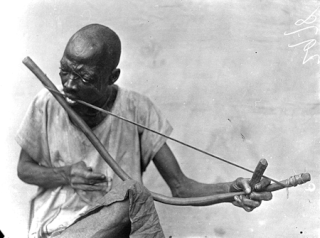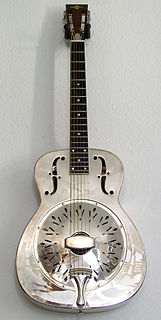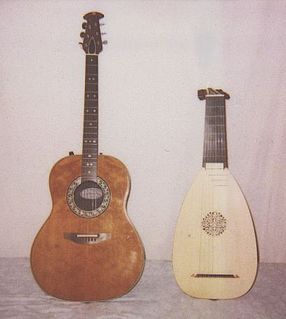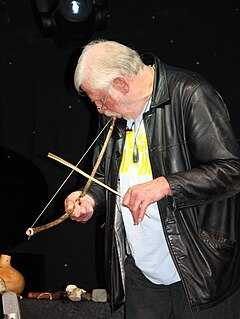Related Research Articles

String instruments, stringed instruments, or chordophones are musical instruments that produce sound from vibrating strings when a performer plays or sounds the strings in some manner.
Hornbostel–Sachs or Sachs–Hornbostel is a system of musical instrument classification devised by Erich Moritz von Hornbostel and Curt Sachs, and first published in the Zeitschrift für Ethnologie in 1914. An English translation was published in the Galpin Society Journal in 1961. It is the most widely used system for classifying musical instruments by ethnomusicologists and organologists. The system was updated in 2011 as part of the work of the Musical Instrument Museums Online (MIMO) Project.

The musical bow is a simple string instrument used by a number of South African peoples, which is also found in the Americas via slave trade. It consists of a flexible, usually wooden, stick 1.5 to 10 feet long, and strung end to end with a taut cord, usually metal. It can be played with the hands or a wooden stick or branch. It is uncertain if the musical bow developed from the hunting bow, though the San or Bushmen people of the Kalahari Desert do convert their hunting bows to musical use.

Ektara is a one-stringed musical instrument used in the traditional music of South Asia, and used in modern-day music of Bangladesh, India, and Pakistan.

The tro is Cambodia's traditional spike fiddles, bowed string instruments that are held and played vertically. Spike fiddles have a handle that passes through the resonator, often forming a spike, on the bottom side where it emerges. The family is similar or distantly related to the Chinese erhu or huqin. The instruments have a soundbox at the bottom of the stick, covered with leather or snake skin. Strings run from pegs at the top of the stick and secured at the bottom, running across the soundbox. The larger the soundbox, the lower the pitch range. Instruments in this family include the two-stringed tro ou, tro sau thom, tro sau toch and tro che, as well as the three-stringed tro Khmer spike fiddle. The two-stringed tros are tuned in a fifth, while the three-stringed tro Khmer is tuned in fourths. The tros, with the exception of the tro Khmer, are strung so that the bowstring is permanently placed between the two stings. When the musician plays, the placement of the bow causes the strings to be played at once, one from below and one from above. In contrast, western fiddles are played with the bow pushing on each string from the outside, as is also the case with the tro khmer.

The đàn gáo is a bowed string instrument, a part of the traditional Vietnamese orchestra. It is similar to the đàn hồ. The instrument originated from South Viet Nam, and is used in entertainment contexts. It can be played alone, as part of an orchestra, or to accompany cải lương. The instrument’s name can be broken down as “đàn” meaning string instrument, and “gáo” literally translated as an aged coconut shell used as a scooper. The đàn gáo is most closely related to the fiddle in Anglo-American culture, and the yehu and banhu in Chinese culture.

A resonator guitar or resophonic guitar is an acoustic guitar that produces sound by conducting string vibrations through the bridge to one or more spun metal cones (resonators), instead of to the guitar's sounding board (top). Resonator guitars were originally designed to be louder than regular acoustic guitars, which were overwhelmed by horns and percussion instruments in dance orchestras. They became prized for their distinctive tone, however, and found life with bluegrass music and the blues well after electric amplification solved the problem of inadequate volume.

Plucked string instruments are a subcategory of string instruments that are played by plucking the strings. Plucking is a way of pulling and releasing the string in such a way as to give it an impulse that causes the string to vibrate. Plucking can be done with either a finger or a plectrum.

The bladder fiddle was a folk instrument used throughout Europe and in the Americas. The instrument was originally a simple large stringed fiddle made with a long stick, one or more thick gut strings, and a pig's-bladder resonator. It was bowed with either a notched stick or a horsehair bow.
Traditional Vietnamese musical instruments are the musical instruments used in the traditional and classical musics of Vietnam. They comprise a wide range of string, wind, and percussion instruments, used by both the Viet (Kinh) majority as well as the nation's ethnic minorities.
The malunga is a single-stringed musical bow played by the Siddi of India, who are the descendants of East African immigrants. It produces two tones, an octave apart, and the knuckle of the hand supporting the instrument may be pressed against the string to vary the pitch. It is struck with a stick and, as with the berimbau of Brazil, the hand holding the stick also holds a rattle. The malunga has a gourd resonator which amplifies the instrument's sound. The placement of this rattle along the string also varies the pitch produced by the Malunga.

The veena, also spelled vina, comprises a family of chordophone instruments from the Indian subcontinent. Ancient musical instruments evolved into many variations, such as lutes, zithers and arched harps. The many regional designs have different names such as the Rudra veena, the Saraswati veena, the Vichitra veena and others.

Bar zither is class of musical instruments within the Hornbostel-Sachs classification system for a type of simple chordophone, in which the body of the instrument is shaped like a bar.
The segankuru is a bowed trough zither, bar zither or musical bow, a string instrument found in Botswana and other areas of South Africa, and found under many names. It consists of a wooden body attached to a tin can resonator, with a single metal string played with a bow. The instruments main role is for self or group entertainment for young men, while herding cattle, etc.

The kse diev or khse mhoy is a Cambodian musical bow with a single copper or brass string and a gourd resonator. The resonator is held to the bow with a nylon cord and is open at the other end. The nylon cord holds on the resonator and acts as a loop around the copper string, bringing it to the stick. The nylon loop acts as the nut on a guitar, the place below which the string vibrates and sound begins.

The eka-tantrī vīṇā was a medieval tube-zither veena in India, with a single string and one or more gourd resonators. The instrument became prominent in Indian music in about the 10th century C.E. as instruments of court music. Alongside the alapini vina and kinnari vina it replaced the harp-style veenas and lute-style veenas in sculpture. It was possibly a forerunner of the rudra vina. It shares its name with the modern single-string drone lute, the ektara.

The ālāpiṇī vīṇā was a medieval stick-zither veena in India, with a single string and a gourd resonator. Later forms added more strings. The instruments became prominent in Indian music after 500 C.E. as instruments of court music. Alongside the eka-tantri vina and kinnari vina it replaced the harp-style veenas and lute-style veenas. The instruments were used in Southeast Asia, both mainland and island nations, and were recorded in sculpture and relief sculpture.